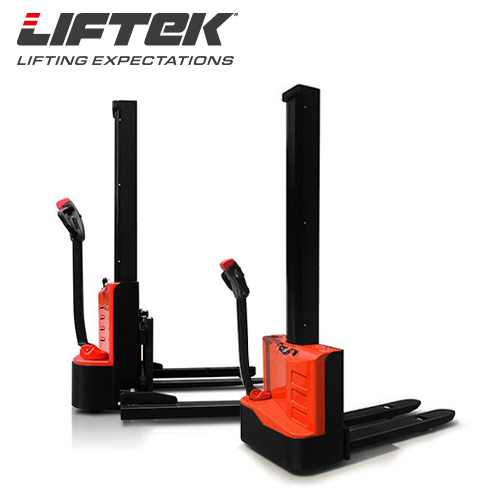When it comes to improving efficiency and safety in your business, your first port of call should always be materials handling. Whether you’re distributing, storing, or moving materials, deploying tools like pallet stackers can act as a powerful force multiplier for your company.
So, how can pallet stackers help add value to your business and what models can bring the biggest benefit to your value proposition?
What is a pallet stacker?
A pallet or ‘walkie’ stacker is a tool designed to help you and your employees make materials handling easier. A pallet stacker uses motors and hydraulics to help product distribution by allowing its users to lift, handle, and transport palleted materials with ease. In effect, combining the functionality of a conventional pallet jack and utility of a motorised lifting truck.
Many modern models are powered by electric batteries to allow businesses to be more energy conscious, save money, and increase the efficiency of their teams. Where operators would normally sit in a cage or raised platform, pallet stackers are pulled behind the user like a cart or operated on foot.
Choosing the right pallet stacker can be a great addition to your company and quality vendors will have a range of options available to suit your unique business needs. These can be heavy-duty stackers for lifting weighty materials or nimble stackers for volume work, with both empowering your teams to go beyond what would be physically or safely possible with conventional equipment.
But with so many options available, finding the right stacker is essential. Making the right choice of kit that would conventionally be a helpful value add-on becomes an essential part of your pipeline.
How can they be used?
As mentioned, pallet stackers are commonly used in warehouses that deal with high-volume or mid-sized items. Picking out a stacker involves sifting through a range of options.
These include smaller mini stackers that are designed for high volume work and smaller loads. Others include functionality for tilting to help with loading and unloading heavier or unpalleted items or choosing a straddle design to save on space and carry tall or stacked loads.
These can all be deployed by trained personnel to load and unload items from shelving, vehicles, or deliver stock to areas on the property.
Where are they most useful?
Pallet stackers are exceptionally useful in warehouses that deal with high-volume or mid-sized items. The small physical footprint of a stacker allows to it be easily and intuitively manoeuvred into a range of positions. This helps massively increase their functionality and makes them a useful tool in a variety of professional scenarios.
If you are looking to get the most out of your stacker, you will want to ensure that they are deployed by trained members of staff in full OSHA compliance. Stackers are effective across a wide range of transport distances, making short jobs quick and efficient, and taking the effort out of longer runs. They are particularly useful when it comes to tasks that require additional loading and manoeuvring time with larger, more cumbersome forklifts or non-motorised pallet carts that need human intervention.
Stackers conventionally work best with small to medium-sized loads of between 600 – 2000 kilograms. This is coupled with their ability to move with speed and precision, allowing for a quick, safe pace and a steady gait – preventing unnecessary effort from employees and using modern technology to take the stress out of work.
Advantages and disadvantages
When it comes to deciding whether to deploy a stacker there are many positives (and a few important negatives) to be aware of.
These include-
Low barrier to entry: Pallet stackers are designed to be simple to use. Larger mechanical items will require specialist skills training to operate, whereas a stacker user can be trained by other members of staff or through a dedicated in-house team. Simple and straightforward, users can be trained in one session, preventing knowledge loss due to staff turnover.
Flexible and effective: Stackers are nimble by design and lend themselves to being used in a variety of professional environments. This means that they can be retained if your company pivots its business or deals with a broad range of products. This means that pallet stackers are effectively future-proof and an investment in one can see it providing benefits for years to come.
Affordable: One of the most cost-effective warehouse items, pallet stackers sit at the halfway point between a flat jack and a larger forklift. Set at an affordable price point, they are cheap to add to your transport chain and allow you to initially rent and provide a test-case to see if you would benefit before purchasing more. They also work to drive efficiencies throughout your supply chain and are much less expensive than purchasing more intensive machinery.
Maintenance: While pallet stackers have mechanical components, all quality models are designed with ease of maintenance in mind. Ongoing checks are simple, and parts are often cheap or easy to access and replace. This is doubly effective when considering forklift trucks that require regular steady maintenance and enjoy a shorter shelf-life than pallet stackers.
Initial coat: While pallet stackers marry cost effectiveness and convenience, there is still a significant outlay for them. Finding the right model for your specific needs is essential and – while it is standard practice to carry out due diligence on your business – researching the right stacker requires a little graft. This can be time-consuming and requires you to check and adjust your established working practice – often causing a significant initial outlay – making it helpful to work with a reliable company to advise you on a suitable model.
Training and caution: While pallet stackers are relatively simple to use, they will still require training for your staff to deploy them and remain fully OSHA compliant. As pallet stackers use electric motors to mitigate weight and allow you to travel at speed, this can make them difficult to stop and they are likely to build momentum when carrying large objects. This can be dangerous to other members of staff and introduce elements of risk which should be weighed up before making a purchase.
What are some good choices?
If you are looking for a stacker that fits your business needs, our comprehensive range of models ensure that you can find the right tool for the task.
Some of our most popular equipment includes:
ES12: A solid entry-level stacker, the ES12 model is set at a generous price-point and combines a mono mast design with robust lifting power. Able to achieve a height of 1855mm, the model is designed to work alongside your employee’s height and carries a 1200kg lifting capacity. This is reinforced by an anti-roll braking device that can prevent injury to operators and bystanders – ensuring the highest standards in safety.
The system is specifically designed where space limitations can cause issues for larger models and is built to be side-operated, ensuring a high degree of safety and reducing the strain on you and your employees or team members. This is also supported by a dedicated crawl speed mode for lifting materials, preventing unnecessary accidents while you strive for greater efficiency.
You can learn more about the stacker by clicking here.
ES10: A step up from the ES12, this stacker is primarily designed for light lifting work, making it perfect for warehouse handling or assisting with production tasks. The system has a high degree of flexibility with a lifting height of 4000mm and a generous 1200kg capacity. The stacker also includes a built-in charger to the main chassis, allowing you to replenish your charge with ease. The system is also powered by a cost-saving gel battery that requires no maintenance to sustain or water refills.
With small dimensions, the ES10 is particularly well-suited for retail and stocking work, allowing for quick turnarounds on goods handling. The device also enjoys a highly stable mast, letting you relocate loads with a high degree of accuracy and safety. Its open design also allows for maximum visibility when working, helping to ensure OSHA compliance and avoid complications with heavy loads. This is coupled with an industry standard Curtis controller that can be widely repaired by forklift servicing companies throughout the UK.
You can learn more about the stacker by clicking here.
ES-RAS: Combining high performance and excellent stability and safety, the RS model is a solid entry-level stacker that is designed to international safety specifications and offers a step-up in terms of power and functionality. The system is designed to work in narrow aisles and operate primarily at medium heights. Set at an economic price-point, the platform has a 1200kg capacity and is a walker-rider hybrid – deploying a h-frame design to maximise stability.
The system is powered by a Zapi control system that guarantees a low-noise, high output electrical engine – maximising the operating life of the unit and providing a high lifting capacity. This is combined with a hydraulic system that prevents droppage due to cut-offs, power steering, and a foldable platform that reduces the device’s footprint; allowing for easy storage and quick deployment. Combining power, control and lifting strength – the ES-RAS model is a solid choice for demanding work, no matter what the task is.
You can learn more about the stacker by clicking here.
ES15: For those that need a little more power, the ES15 series is the next logical step in the series, with the walkie stacker able to lift 1.5 tonnes, despite enjoying one of the smallest physical footprints on the market. Build around a mast system, the walkie is engineered to efficiently manage heavy loads through its high-strength vertical gearbox. This also includes a steady, reprogrammable uptime to ensure the highest standards in safety when lifting objects of all specifications and sizes. Built with strong hydraulics, the uptick in power isn’t accompanied by an increase in volume, thanks to a highly dependable system that locks to prevent dropping due to power failures.
This commitment to safety is continued in the model through a dedicated emergency reverse button and disconnector that separates the stacker from its power source if it spins out of control. With added limit protections, ergonomic handles, and a trouble-shooting indicator, the system is tailor-made for high use, heavy lifting environments – making it a valuable asset for any successful, labour-intensive business.
You can learn more about the stacker by clicking here.
If you are thinking of pallet stackers for your own warehouse then get in touch to chat about what you need with our friendly team.

